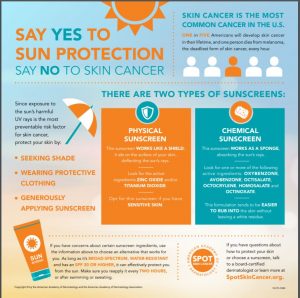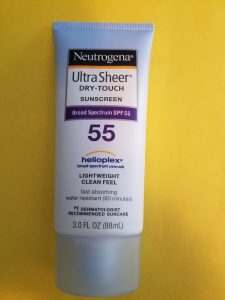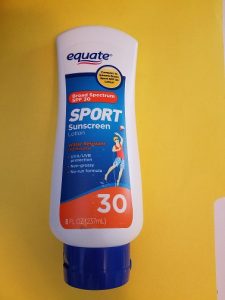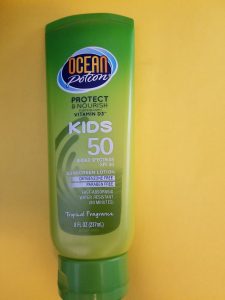Jul
08

Posted by Susan Halpin on July 8th, 2019
Posted in: Blog, NLM Resources, Public Health
Tags: babies and sunscreen, Broadspectrum, kids and sunscreen, SPF, sun protection, sunblock, sunscreen, water resistant sunblock, waterproof sunblock

New England’s rainy spring has finally turned into summer. This past July 4th brought a string of sunny and hot days with lots of time spent outside. As I took out my sunscreen and looked at the SPF rating of 55 I thought to myself that if anyone asked me to explain what SPF 55 means I would have a hard time providing a clear explanation. It turns out I am not alone in admitting I find sunscreen lingo confusing!”
What’s in Your Closet?
I found the sunscreen products pictured in this post in my closet. I even found one product that had an expiration date of 2016! Who knew that sunscreens have expiration dates? As I looked at all of these products, I became a little confused.
I hope to give you some useful information about sunscreen. The information in this post was very easy to find as I used the NLM consumer health website MedlinePlus.gov. I typed “sunscreen” into the search box and found the information for this article from the American Academy of Dermatology, Inc. https://www.aad.org/public/spot-skin-cancer/learn-about-skin-cancer/prevent/sunscreen-labels/how-to-decode-sunscreen-lingo
 According to a JAMA Dermatology study, less than half of the patients at a dermatology clinic could explain the meanings of “Broad Spectrum” and “SPF.
According to a JAMA Dermatology study, less than half of the patients at a dermatology clinic could explain the meanings of “Broad Spectrum” and “SPF.
Broad Spectrum and SPF
Terms like Broad Spectrum and SPF have official meanings from the FDA. Broad Spectrum means that sunscreen can protect you from the sun’s harmful ultraviolet A (UVA) and ultraviolet B (UVB) rays. This important to prevent skin cancer, early aging i.e. wrinkles, premature age spots and sagging.
SPF describes how well a sunscreen protects you from sunburn. An easy way to remember the meaning of “SPF” is to think about it as “sunburn protection factor.” It is important to remember that no sunscreen can filter out 100% of the UVB (ultra violet burning) rays. The number after SPF describes how much of the UVB light the sunscreen filters out. For example SPF 15 filters out 30%, SPF 30 filters out 95%.
Waterproof vs. Water Resistant
No sunscreen is waterproof because sweat and water wash sunscreen away from our skin. Therefore, the FDA no longer allows the term “waterproof” on labels. The term “Water Resistant” is permitted, as some sunscreens have been tested and earn their ability to post the info on their product. Below are the FDA definitions and how often sunscreen must be applied to the skin to be effective.
Water resistant:The sunscreen stays effective for 40 minutes in the water. At that time, you’ll need to reapply.
Very water resistant:The sunscreen stays effective for 80 minutes in the water. Yes, after 80 minutes, you’ll need to reapply.
If sunscreen is not water resistant, to continue protecting our skin from the sun when outdoors, we must reapply sunscreen, every 2 hours, after toweling off, when sweating.Even if your skin remains dry sunscreen re-apply sunscreen every 2 hours to remain effective.

Difference Between Chemical Sunscreen or Physical Sunscreen?
Each of these protects your skin differently and contains different active ingredients. Here’s a summary of the basic differences:
Chemical sunscreen:Protects you by absorbing the sun’s rays. May contain one or more of many possible active ingredients, including oxybenzone or avobenzene. The Neutrogena brand (the back of the tube) pictured here sunscreen lists Oxybenzone and Avobenzene as active ingredients.
Physical sunscreen: Protects you by deflecting the sun’s rays. Contains the active ingredients titanium dioxide and/or zinc oxide. Some sunscreens use both types of active ingredients, so they contain one or more active ingredient found in physical sunscreen and chemical sunscreen.

What does the word “sports” mean on sunscreen?
The FDA has NOT defined this term for sunscreen.
When you see the word “sports” on sunscreen, it usually means that the sunscreen will stay on wet skin for either 40 or 80 minutes. To be sure, check the label. You may also see the words “water resistant” or “very water resistant.” To protect your skin, you’ll need to reapply sports sunscreen when you’re sweating (every 40 or 80 minutes), after toweling off, after getting out of the water.

What do the words “Kids” or Baby” mean on sunscreen?
Like the word “sports,” the FDA has not defined these terms for sunscreen. The AAD recommends the following when using sunscreen on babies and toddlers.
Children younger than 6 months – Protect babies or kids from the sun by keeping them in the shade and dressing them in clothing that covers their skin. It is important to cover skin, but not so much that they overheat. If possible, avoid using sunscreen on these children.
Children 6 months and older – Choose a sunscreen that contains zinc oxide or titanium dioxide, as sunscreen with these ingredients are most appropriate for the sensitive skin of infants and toddlers. Keep children in the shade and dress them in clothing that will protect their skin from the sun even when using sunscreen.
There is more information about sunscreen I could tell you, but you may it more beneficial to read the information yourself from the American Academy of Dermatology in the link provided. Also take a look at the infographic provided in the link. Enjoy your summer and remember to use sunscreen!